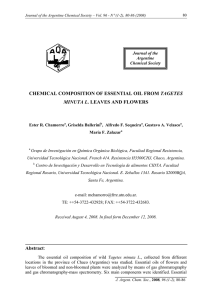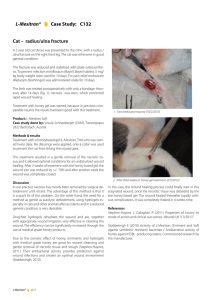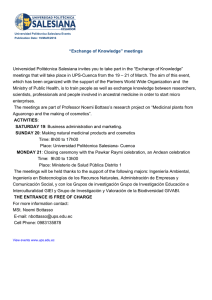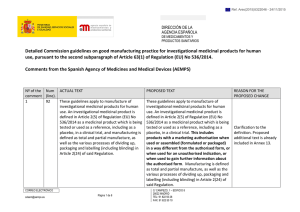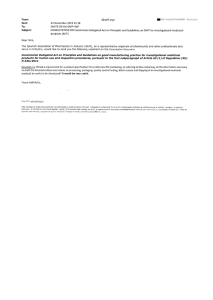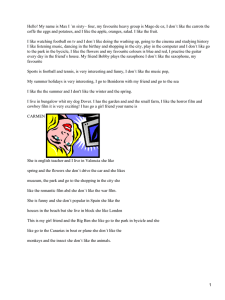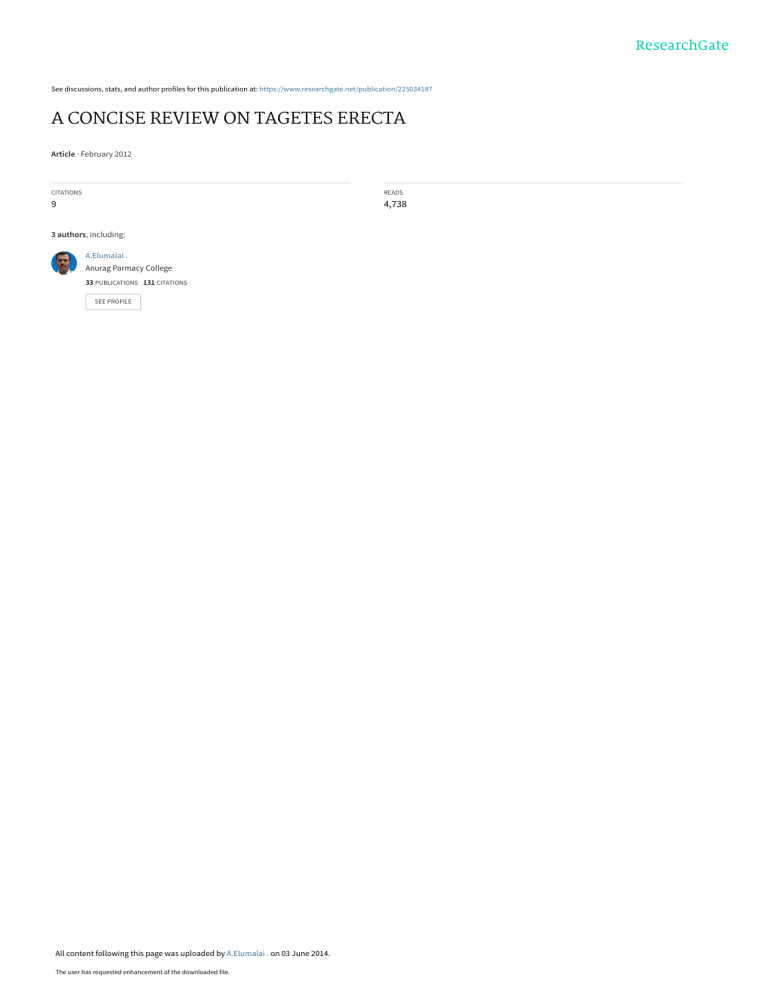
See discussions, stats, and author profiles for this publication at: https://www.researchgate.net/publication/225034187 A CONCISE REVIEW ON TAGETES ERECTA Article · February 2012 CITATIONS READS 9 4,738 3 authors, including: A.Elumalai . Anurag Parmacy College 33 PUBLICATIONS 131 CITATIONS SEE PROFILE All content following this page was uploaded by A.Elumalai . on 03 June 2014. The user has requested enhancement of the downloaded file. Vol 3 | Issue 1| 2012 | 16-19. e - ISSN 2249-7544 Print ISSN 2229-7464 INTERNATIONAL JOURNAL OF PHYTOPHARMACY RESEARCH www.phytopharmacyresearch.com A CONCISE REVIEW ON TAGETES ERECTA G. Gopi1, A. Elumalai2 and P. Jayasri3 1 Department of Pharmaceutics, Mahathi College of Pharmacy, CTM X Road, Chittoor (Dt), Madanapalle, Andhra Pradesh, 517 319. 2 Department of Pharmacognosy, Anurag Pharmacy College, Ananthagiri (V), Kodad (M), Nalgonda (Dt), Andhra Pradesh, 508 206. 3 Department of Pharmacognosy, Santhiram College of Pharmacy, Srinivas Nagar, Kurnool (Dt), Nandyal, Andhra Pradesh, 518 501. ABSTRACT Medicinal plants have been of great importance to the health care needs of individuals and their communities. The use of herbal preparations made from medicinal plants is widespread in developing countries. The healing powers of traditional herbal medicines have been realized since antiquities. About 65% of the world populations have access to local medicinal plant knowledge system. India is sitting on a gold mine of well-recorded and traditionally well practiced knowledge of herbal medicine. This article discusses about the medicinal values of Tagetes erecta. In this communication, we reviewed the pharmacological and phytochemistry of Tagetes erecta and its application in the treatment of various ailments like the flower parts of plants are used as a hepatoprotective, insecticide, anti-oxidants and analgesic. This review discusses the investigation made by various workers related to chemical constituents, pharmacological action and toxicological studies of this plant since years till date. Key words: Tagetes erecta, Pharmacological Actions, Toxicological Studies. INTRODUCTION Medicinal plants and derived medicine are widely used in traditional cultures all over the world and they are becoming increasingly popular in modern society as natural alternatives to synthetic chemicals [1]. In the last few decades there has been an exponential growth in the field of herbal medicine. It is getting popularized in developing and developed countries owing to its natural origin and lesser side effects [2]. At the present juncture, the modern conventional healthcare is burdened with great problems of unsafe medicines, chronic diseases, resistant infections, auto immune disorders and degenerative disorders of ageing, despite great scientific advances. More than 70% of India’s 1.1 billion populations still use these non-allopathic systems of medicine [3]. India possesses almost 8% of the estimated biodiversity of the world with around 0.126% million species [4]. The World Health Organization (WHO) estimated that approximately 80% of world population relies mainly on traditional medicines, mostly plant drugs in their health care. Today, Ayurveda coexists with modern system of medicine, and is still Corresponding Author: G. Gopi widely used and practiced. About 30% of the currently used therapeutics is of natural origin [5]. Botanical Study Kingdom Order Family Genus Species : Plantae : Asterales : Asteraceae : Tagetes : Tagetes erecta Traditional Uses The leaves are reported to be effective against piles, kidney troubles, muscular pain, ulcers, and wounds. The pounded leaves are used as an external application to boils and carbuncles. Chemical Constituents Lutein is an oxycarotenoid, or xanthophyll, containing 2 cyclic end groups (one beta and one alphaionone ring) and the basic C-40 isoprenoid structure common to all carotenoids. It is one of the major constituents and the main pigment of Tagetes erecta. Email:- [email protected] 16 Vol 3 | Issue 1| 2012 | 16-19. Pharmacological Actions Anti-bacterial Activity Rhama and Madhavan reported the anti-bacterial activity of different solvents of Tagetes erecta flowers against Alcaligens faecalis, Bacillus cereus, Campylobacter coli, Escherchia coli, Klebsiella pneumoniae, Pseudomonas aeruginosa, Proteus vulgaris, Streptococcus mutans and Streptococcus pyogenes. The flavonoid possesses anti-bacterial activity against all the tested strains and shows maximum zone of inhibition for Klebsiella pneumoniae (29.50 mm). The flavonoidPatulitrin is one of the potential elements for its antibacterial activity [6]. Antimicrobial Activity Ruddock et al reported the anti microbial activity in 19 plants used in Colombian traditional medicine for cutaneous infections, were screened against Neisseria gonorrhoeae (NG) by disc susceptibility assay. In all, 71% of the crude extracts exhibited antibacterial activity against the antibiotic susceptible NG strain, whereas 10% of the extracts inhibited penicillinase-producing NG strain GC1– 182. The Tagetes erecta flower parts showed maximum inhibitory action against NG strain [7]. Anti-oxidant activity Chivde et al reported the antioxidant studies on the ethanolic extract of Tagetes erecta flowers by three different assays like DPPH, reducing power and super oxide radical scavenging activity at different concentrations were used. In all the three assay, Tagetes erecta showed better reducing power than the standard (i.e. ascorbic acid), and super oxide anion scavenging activity and DPPH antioxidant activity showed less than standard. However, ethanolic extract of Tagetes erecta demonstrated antioxidant property in all the in Vitro models [8]. Hepatoprotective activity Bose et al reported the hepatoprotective activity in flowers of Tagetes erecta by carbon tetra chloride induced hepatopathy model. The ethanolic extract showed the increase in serum ALT, AST, ALP and bilirubin levels. Ethyl acetate fraction of T. erecta (EATE) at the dose of 400 mg/kg orally significantly decreased the elevated serum marker enzymes and level of bilirubin almost to the normal level compared to CCl4-intoxicated group. Histological changes in the liver of rats treated with 400 mg/kg of EATE extract and CCl4 showed a significant recovery except cytoplasmic vascular degenerations around portal tracts, mild inflammation and foci of lobular inflammation. Phytoconstituents such as flavonoids, terpenoids and steroids are responsible for the observed hepatoprotective activity [9]. Insecticidal activity Nikkon et al reported the insecticidal activity in Tagetes erecta flowers against a stored product insect pest, Tribolium castaneum (Herbst). The chloroform fraction showed highest toxicity against both the larvae and adults of Tribolium castaneum followed by petroleum ether fraction and ethanol extract. The LC values of chloroform fraction against first, second, third, fourth, fifth and sixth instar larvae were 11.64, 14.23, 19.26, 29.02, 36.66, 59.51 μg/cm2 (72 h.), respectively and for adults the value was 65.93 μg/cm2 (72 h.). No mortality was observed in control. Finally they concluded that the flower of Tagetes erecta might be a pesticide against Tribolium castaneum [10]. Mosquitocidal activity Nikkon et al reported the mosquitocidal activity in ethanolic, chloroform and petroleum ether extracts of Tagetes erecta flowers against different instars of Cx.quinquefasciatus. Among the tested samples the chloroform soluble fractions showed the highest toxicity and consequently the LC50 values (14.14µg/mL, 17.06µg/mL, 36.88µg/mL and 75.48µg/mL) for all instar larvae of Cx.quinquefasciatus. The larvae showed comparative tolerance in the course of increasing age and time. From this they concluded the flowers of Tagetes erecta having good mosquitocidal activity [11]. Nematicidal activity Husain et al reported the nematicidal efficacy of four medicinal plants viz. Azadirachta indica, Calotropis procera, Datura stramonium and Tagetes erecta was ascertained for the control of M. incognita. All leaf amendments at different dosages significantly improved the plant growth characteristics of okra and reduced rootknot infections compared with the untreated control [12]. Wound healing activity Ibrahim et al reported the wound healing activity of carbopol gels prepared from hydro alcoholic extracts of Gymnema sylvestere (GE) and Tagetes erecta Linn. (TE) in excision wound model and burn wound models in albino mice. In excision and burn wound models, the GE and TE treated animals showed significant reduction in period of epithelization and wound contraction and combined gel showed accelerated wound healing activity may be because of synergism. The enhanced wound healing activity of hydro alcoholic extracts may be due to free radical scavenging action and the phytoconstituents (flavonoids) present in it which either due to their individual or additive effect fastens the process of wound healing [13]. Anti oxidant and Analgesic activity Bashir and Gilani reported the in vitro anti oxidant and in vivo analgesic activities (acetic-acidinduced abdominal writhing) on flower extracts of Tagetes erecta. The results revealed the presence of pronounced antioxidant potential on dose-dependent (100 and 300 mg/kg) and analgesic effect also. The antioxidant and analgesic activities obtained seem to be in good accordance with the medicinal uses of Aztec marigold as an anti-inflammatory and analgesic [14]. 17 Vol 3 | Issue 1| 2012 | 16-19. Larvicidal activity Marques et al reported the larvicidal activity of essential oil from Tagetes erecta against 3rd instars of Aedes aegypti and to determine the amounts of larvicidal thiophenes in all plant tissues. The oil obtained by steam distillation and analyzed by gas chromatography/mass spectrometry showed 14 compounds. The main compounds were piperitone (45.72%), d-limonene (9.67%), and piperitenone (5.89%). The essential oil was active against larvae of Aedes aegypti, with LC50 of 79.78 µg/ml and LC90 of 100.84µg/ml. The larvicidal thiophene contents were higher in the roots and flowers as demonstrated by high-performance liquid chromatography analysis. Thus, Tagetes erecta constitutes a good source of varied compounds showing larvicidal activity against Aedes aegypti [15]. Figure 1: Flowers of Tagetes erecta CONCLUSION The extensive literature survey revealed that Tagetes erecta is important medicinal plant with diverse pharmacological spectrum. The plant shows the presence of many chemical constituents which are responsible for varied pharmacological and medicinal property. The evaluation needs to be carried out on Tagetes erecta in Sub acute toxicity studies Nikkon et al reported the sub acute toxicity studies in chloroform fraction from ethanol extract of Tagetes erecta flower by solvent-solvent partitioning method. The sub acute toxicity of chloroform fraction was evaluated on Long Evan’s rats at 200 and 400 mg/kg doses and the results obtained from chloroform fraction treated rats were compared with untreated controls. Treatment of chloroform fraction at 200 and 400 mg/kg doses did not make any significant alterations on the hematological and biochemical parameters of rats when data were compared with that of untreated controls. Histopathological examination also showed no detectable changes in liver, kidney, heart and lung of chloroform fraction treated rats. This study revealed that the chloroform fraction of Tagetes erecta had no toxic effects [16]. Figure 2: Chemical structure of Lutein order to uses and formulation of the plant in their practical clinical applications, which can be used for the welfare of the mankind. ACKNOWLEDGEMENT The authors are thankful to Mrs. Pramela for providing literature survey facility to carry out the work. REFERENCES 1. Ben-Erik Vanwyk, Micheal Wink, Medicinal plants of the world. Published by Briz Publication, South Africa, Edition I, (7), 2009, 43. 2. B.V. Patel, A Report of The Seminar on, Herbal Drugs: Present Status and Future Prospects, Perd Centre, Ahmedabad, 2001. 3. Thomas Paul, A Devasagayam, Radiation Biology and Health Sciences Division, Bhabha Atomic Research Centre, Mumbai, 2006. 4. B. Jain, C. Jitendra Kumane, S. Sheetal Bhattacharya. Indian Journal of Traditional Knowledge, 5 (2), 2006, 237-242. 5. Research Guidelines for Evaluating the Safety and Efficacy of Herbal Medicines”=, World Health Organization, Regional office for the Western Pacific, Manila, 1993, 1-2. 6. S.Rhama and S. Madhavan. Antibacterial Activity of the Flavonoid-patulitrin isolated from the flowers of Tagetes erecta L. International Journal of Pharm Tech Research, 3(3), 2011, 1407-1409. 7. Patrick Ruddock S, Marijo Charland, Sandra Ramirez, Andres Lo´pez, Neil Towers G H, John Arnason T, Mingmin Liao, Jo-Anne Dillon R. Antimicrobial Activity of flavonoids from Piper lanceaefolium and other colombian medicinal 18 Vol 3 | Issue 1| 2012 | 16-19. 8. 9. 10. 11. 12. 13. 14. 15. 16. plants against antibiotic susceptible and resistant strains of Neisseria gonorrhoeae. Sexually transmitted diseases, 38(2), 2011, 81-88. Basavaraj Chivde V, Karnakumar Biradar V, Rajabhau S, Shiramane, Kamshetty Manoj V. In vitro antioxidant activity studies of the flowers of Tagetes erecta L. (Compositae). International Journal of Pharma And Bio Sciences, 2(3), 2011, 223-229. Ranjan Kumar Giri, Anindya Bose and Subrat Kumar Mishra. Hepatoprotective Activity of Tagetes erecta against carbon tetrachloride-induced hepatic damage in rats. Acta Poloniae Pharmaceutica n Drug Research, 68(6), 2011, 999-1003. Farjana Nikkon M, Rowshanul Habib M, Ezaul Karim and Zennat Ferdousi. Insecticidal activity of flower of Tagetes erecta against Tribolium castaneum (Herbst). Research Journal of Agriculture and Biological Sciences, 5(5), 2009, 748753. Motiur Rahman M, Ekramul Haque M. Tagetes Erecta Linn and its Mosquitocidal Potency Against Culex Quinquefasciatus. Asian Pacific Journal of Tropical Biomedicine, 2009, 186-188. Farjana Nikkon M, Rowshanul Habib, Zahangir Alam Saud and Rezaul Karim M, (Medicinal Plants: Conservation & Sustainable Use) Efficacy Evaluation Of Azadirachta Indica, Calotropis Procera, Datura Stramonium and Tagetes Erecta Against Root-Knot Nematodes Meloidogyne Incognita. Pak. J. Bot, 43, 2011, 197-204. Muhammad Arshad Hussain, Tariq Mukhtar and Muhammad Zameer Kayani. Combined wound healing activity of Gymnema sylvestere and Tagetes erecta Linn. International Journal of Pharmaceutical Applications, 2(2), 2011, 135-140. Bashir S, Gilani AH. Studies on the antioxidant and analgesic activities of Aztec marigold (Tagetes erecta) flowers. Phytother Res, 22(12), 2008, 1692-4. Márcia M, Marques M, Selene M, Morais Ícaro G, Vieira P, Mariano G, Vieira P, Ana Raquel, Silva A, Raimundo Rafael De Almeida, Maria Izabel Guedes F. Larvicidal activity of Tagetes erecta against Aedes aegypti. Journal of the American Mosquito Control Association, 27(2), 2011, 156-158. Farjana Nikkon, Rowshanul Habib M, Zahangir Alam Saud, Rezaul Karim, Apurba Kumar Roy, Shahriar Zaman. Toxicological evaluation of chloroform fraction of flower of Tagetes erecta on rats. Int. J. Drug Dev & Res, 1(1), 2009, 161-165. 19 View publication stats

